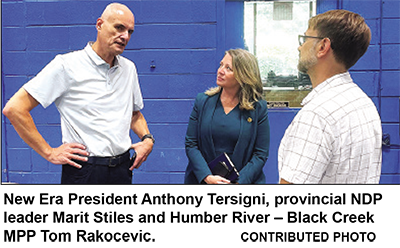By Sean Delaney
On July 24th, the Emery Village BIA joined forces with Ontario NDP Leader and Official Opposition Leader Marit Stiles for an in-depth roundtable at New Era Tool and Die, hosted by company president Anthony Tersigni. The goal: give local manufacturers a direct line to government ears and ensure their realities are part of the policy conversation.
Humber River–Black Creek MPP Tom Rakocevic, Emery Village BIA Executive Director Sandra Farina, were also at the table, adding context from the broader business community. This was one in a series of BIA-led discussions aimed at making sure local industries are not only heard, but actively factored into decision-making at all levels.
While tariffs dominated much of the talk, the focus wasn’t on pointing fingers — it was on solutions. “We’re not just here to oppose everything. We want to work with the opposition and with business to come up with solid, helpful suggestions to get things done,” Stiles said. 
Tersigni didn’t sugar-coat the impact of trade instability. For decades, his company’s production lines ran at near-full capacity — 55 to 60 hours a week. Now, he says, “We’re down to 37 hours. That’s a third fewer hours, and for the first time in 25 years, we’re not running full tilt.”
“If I can’t give them full-time work, they’ll have to look elsewhere — and once they leave, they’re gone,” he said.
His concern extends beyond the company’s bottom line. New Era’s staff is highly skilled, with many employees logging more than three decades of service. “You can’t replace that kind of talent easily, or at all.”
Part of the challenge lies in supply chains that have shifted from a price-driven model to one where geography often dictates the cost. Tariffs on raw materials — even under agreements like USMCA — have created unpredictable spikes. Tersigni recounted an American customer blindsided by a 25 percent duty on a $100,000 order, despite the product being tariff-exempt on paper. “That kind of thing changes how you do business overnight,” he said.
The conversation turned repeatedly to the need for immediate, practical measures. Tersigni argued that direct financial support could be a lifeline for many small and medium-sized manufacturers. But more than cash, he sees value in government purchasing power.
“We can adapt. We’ve done it before. We just need a fair chance and a stable environment.”
The group discussed “nation-building” projects — from affordable housing to transit manufacturing — as opportunities to redirect existing capacity into sectors where Canada already has resources and know-how. The lumber industry, for example, could supply materials for tens of thousands of homes a year domestically, instead of exporting most of it.
Tersigni also voiced frustration with the procurement process, which often favours a handful of major firms. “We’ve been here since 1963, worked on projects like the Canadarm, and yet we can’t get near some of these contracts. The system isn’t set up for companies like ours to compete.”
Stiles agreed that this is a barrier worth addressing. Simplifying the process and prioritizing Canadian-made goods, she argued, would create a ripple effect through the economy. “Even in something as simple as a government vehicle list, only two out of five options are made in Canada. That has to change,” she said.
As the discussion wrapped, one theme was clear: local manufacturers are looking for collaboration, not confrontation. They want a seat at the table, a voice in shaping the future, and the tools to keep doing what they do best — building, innovating, and employing.
“It doesn’t matter to me who’s in power,” Tersigni said. “Just be a voice for us. We all need the same message when we’re under pressure like this.”
For Stiles, that sentiment struck home. “There’s no monopoly on good ideas,” she said. “The sooner we start putting them into action, the better for all of us.”














